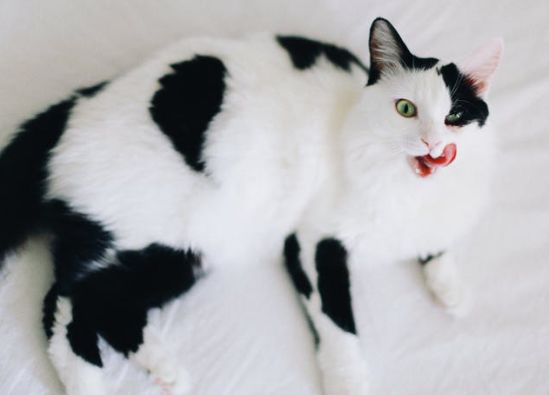Mixing dry and wet cat food — the correct ratio is vital!
Many cat owners wonder how much dry and wet food they should be giving their cats. The ultimate aim is to make sure your pet has a good a supply of all nutrients, vitamins and trace elements. Things can get a bit complicated, particularly if your feline has a clear preference for one type of food. But luckily, thanks to the high-quality recipes used in today’s cat food such as the Green Petfood range, you can’t go too far wrong whether you choose wet or dry food. Here, we offer some vital tips on successfully mixing dry and wet cat food.
Can you mix dry and wet catfood?
The answer to this question is a decisive yes. Lots of cats like the variety this brings to their diet and are delighted to find something crunchy in their bowl in addition to delicious and aromatic wet food. But there are a couple of things you need to know about both types of food. The main thing is to get a high-quality feed to ensure an optimal diet. That’s why you should carefully examine the precise ingredients in the cat food. A high proportion of undefined by-products or even sugar should always be avoided in your cat’s diet.
Dry food: the key issues
Manufacturing dry food involves removing the liquid content so it can be pressed into pellets or kibble. Kibble comes in various shapes, including special varieties for kittens, or for pets that bolt their food or have intolerances. Cats do not generally like chewing anything for very long, which is why the kibble should not be too big.
Dry food has some benefits, because it …
- is almost odourless
- keeps for longer, e.g. if everything in the bowl is not eaten
- is often less expensive
- can prevent tartar
- is easy to divide into portions
Since dry food has a very low volume due to the liquid having been removed, you need to make sure you do not offer too much. Otherwise, there is a risk your cat may become overweight. When serving dry food, always stick to the manufacturer’s feeding recommendations, which can usually be found on the back of the pack. This food consists of between 60 – 70 percent protein in addition to oils and fats. The best dry food for cats is made using high-quality, sustainably cultivated ingredients, a balanced blend of meat, plant-based ingredients, fats, oils and crude ash.
Tip
Make sure your cat drinks enough as dry food alone will not provide sufficient water. The best way to do this is to position little saucers of water in various places around your home to encourage your cat to drink as they happen to be passing by.
Wet food: very popular with most cats!
Wet food (or moist food) is aromatic and comes in lots of delicious varieties. It contains a high proportion of water – sometimes up to 80 percent. This is beneficial for cats as they often tend to drink too little. There are evolutionary reasons for this because a cat’s anatomy is designed for survival in the desert, where very little water may be available. However, insufficient water over a long period can cause kidney stones and other health problems in cats. So a high-quality wet food for catshas a significant advantage here over dry food because it means cats get plenty of water directly from their food.
The consistency of wet food is very similar to what would naturally be eaten in the wild, which makes it very popular with most cats. Wet food is available in tins, little bowls or pouches and comes in the form of pâté, mousse or tiny chunks in a nice sauce or jelly. This means you can include plenty of variety in your cat’s diet! Some cats also have a preference for a particular type of meat, for example chicken, fish or beef.
Expert tip
If wet food has a very strong smell, this can be a sign that it contains substandard ingredients that are being masked with a powerful aroma. You should inspect the product more closely!
With wet food from Green Petfood, you can be confident that only high-quality, species-appropriate ingredients will end up in your cat’s bowl. But make sure wet food is not left in the bowl too long if your cat does not finish every last morsel. This is because wet food goes off more quickly than dry food. The same is true of open sachets in the fridge. As always, good ingredients and a high meat content are vital in wet food, while sugar is a no-no!

Which is better, dry food or wet food?
As you can see, both types of cat food have their advantages and disadvantages. Many pet owners are under the impression that wet food is higher in quality than dry food, but that is not the case at all.
Quite the contrary: if a cat won’t accept wet food or is suffering from specific intolerances, even vets are generally quite happy to recommend exclusively offering a high-quality dry food.
Either dry food or wet food from Green Petfood makes an ideal complete feed. But to offer cats a good supply of liquid and offer sufficient variety, we recommend mixing dry and wet cat food.
Mixing dry and wet cat food: how it’s done!
It is very simple to offer a mixture of dry and wet food. You should always note the following:
- fixed feeding times
- fixed quantity of food
- sufficient water
In terms of the quantity of food, you need to remember that dry food contains all the nutrients in a more concentrated form and has a much lower volume than wet food. It is easy for your cat to apparently eat relatively small quantities and still become too fat. Make sure you follow the specifications on the pack to avoid obesity and the need for a strict diet!
Stick to feeding times!
Recommended feeding times involve putting out food three times a day: morning, midday and evening. Cats are creatures of habit and, as all cat lovers know, they have a wonderful knack of turning up expectantly at their bowl precisely at feeding time. Do not mess with this internal clock!
Dry food should also be served at a specific time of day, with any deviations kept to a minimum. It is fine to leave dry food out a bit longer. But do not be tempted to top up the helping as otherwise your cat may focus too much on this kind of food with the result that they reject their wet food later.
Two thirds wet food, one third dry food
We recommend dividing your cat’s food across three meals: two portions of wet food, one portion of dry food. For dry food you should simply take one third of the recommended daily amount indicated on the pack. With all varieties of food, this will depend on:
- weight
- size
- breed
- activity levels
- whether the cat has been neutered
Never offer bigger quantities! Some food packaging indicates the daily ration for mixing dry and wet cat food.
For wet food, you should also stick to the recommended daily amount and offer a daily quantity of two thirds in two separate portions – the third portion consists of dry food. Any of the wet food that is not eaten should be transferred to the fridge after a while to prevent it going off. You can put these leftovers out again with the next portion of wet food.
Tip
You can also offer dry food as an occasional treat between meals, rather than just putting out a bowl for your cat. Most cats really enjoy this crunchy food as a snack. This also avoids adding calories through extra treats, and the dry food is good for throwing games or for concealing in a cat activity board.

What if my cat won’t accept mixing dry and wet cat food?
Although many cat owners get on very well with the 2:3 solution for their cats, you can also opt for a different nutritional ratio, for example 50:50, or a greater volume of dry food than wet food.
You could try two portions of dry food to one portion of wet food. Your choice will depend on your cat’s eating habits and needs, your vet’s recommendation, as well as daily rhythms.
Once you have decided that mixing dry and wet cat food in some way is the right approach and you have got your system working well for your cat, you should stick to this routine.
Water is important!
If you are mainly offering wet food, your cat’s fluid intake requirements will be well covered.
Even so, you should always make sure fresh water is readily available in several bowls or from a drinking fountain.
Daily cleaning is also very important to avoid germs developing. Particularly after dry food, cats like something to “wash it all down”.
Careful with sensitivities and allergies!
Some pets can eat anything, others are prone to digestive problems such as diarrhoea or vomiting at the slightest change in their diet. If your cat belongs in the second category, make sure when mixing dry and wet cat food that you do not also alter the variety. If you have successfully used a particular dry or wet food, stick with it, or only change it very carefully, for example by slowly adding increasing amounts of the new wet food.
If you switch to mixing dry and wet cat food and your cat has problems after a while, for example rejecting the wet or dry food or developing diarrhoea, you will need to change something. Think about whether the selected mixed feeding method is right for your cat. You may be able to adjust the proportions of the different kinds of food or switch to a product designed for cats with sensitive stomachs.

Mixed feeding and BARF
If your cat is being fed in accordance with the BARF principle (either entirely or partially), you can still mix dry and wet food.
For example, you can combine BARF with offering dry food.
However, you will need to take responsibility yourself to ensure that all vital nutrients that would have been provided via the wet food are covered by the BARF portion of your cat’s diet.
What about snacks and treats?
Of course, even if you are mixing dry and wet cat food you can still give your cat the occasional snack. Once again, the important thing is focusing on high quality and avoiding anything containing sugar. Connect snacks with a game, for example by hiding a crunchy treat inside a toy, so your cat has to figure out how to get at the snack before eating it. You can also show your devotion to your pet with a homemade cat treat. This gives you full control over the ingredients and you can factor in your cat’s detailed requirements.
In summary: a perfect diet by mixing dry and wet cat food!
If you stick to the recommended feeding quantities and times, mixing dry and wet cat food is an ideal way to offer your cat a more varied menu. At the same time, your cat gets used to eating at fixed times and won’t be begging for food throughout the day.
Mixing dry and wet cat food also ensures an optimal supply of protein, vitamins, nutrients, trace elements and fluid: if your cat is reluctant to drink, you won’t need to worry if the water in its drinking bowl is rarely touched.
















